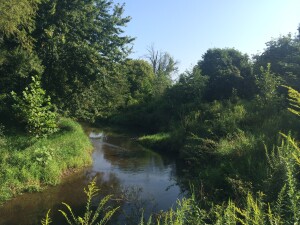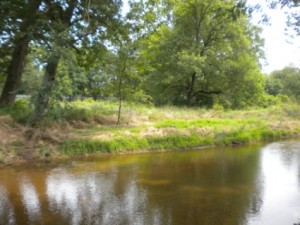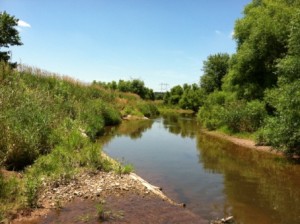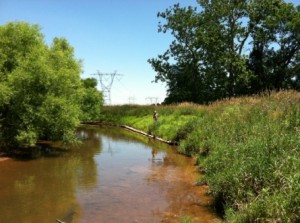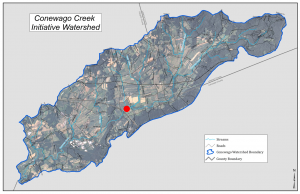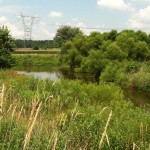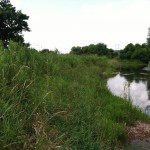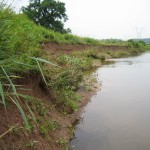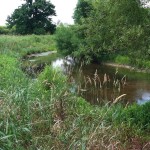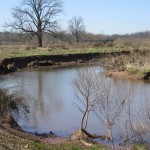The Hershey Meadows Watershed Restoration Project
In 2007, TCCCA received a Section 319 grant from the Pennsylvania Department of Environmental Protection to begin work on the Hershey Meadows watershed restoration project. TCCCA partnered with the U.S. Fish and Wildlife Service on the project. Work began in fall 2009 to restore nearly a mile of eroded stream banks and 15 acres of wetlands. In 2011, Wild Resources, Inc. and volunteers planted nearly 3,000 trees and shrubs along the creek, restoring 20 acres of forest riparian buffer.
Stream Restoration
Prior to restoration, the banks of the Conewago at Hershey Meadows were very eroded and steep. With each storm and high flow event, more and more sediment would erode from the bank and wash downstream, adding more pollution to the stream. To restore the stream, the channel was redesigned to eliminate the steeply eroded banks. Using heavy earth moving equipment, the banks were regraded and log and rock structures were installed to enhance fish habitat, provide natural flow channels, and stabilize eroding banks. Restoration structures include bankfull benches, log vanes and mudsills.
Wetlands Restoration
Approximately fifteen acres of wetlands were restored in the floodplain of the site. To restore the wetlands, two cells were created through the installation of dikes and topsoil was distributed to create islands and other areas for habitat and vegetative diversity. Emergency spillways with removable boards were constructed so that water levels can be adjusted to accommodate plant and wildlife species needs. The restored wetlands enhance the site’s ability to receive and process natural runoff and improve wildlife habitat.
Riparian Buffer Restoration
Approximately 20 acres of forest riparian buffer along the entire stretch of the Conewago at the site was restored. A riparian forest buffer is an area along a stream that is planted in native trees and shrubs. Riparian forest buffers filter pollution from runoff, help prevent downstream flooding by soaking up stormwater and high flows like a sponge, shade and cool waters, and provide food for aquatic insects during fall leaf drop. Nearly 3,000 native trees and shrubs were planted to create this buffer. 16 different species were planted, including river birch, pin oak, sycamore, red oak, black cherry, and chokeberry.
Incorporated Designs
Bankfull benches operate like “mini floodplains” to receive water during times of high flow when the stream tops its banks. This dissipates the energy of the stream and prevents it from eroding stream banks. The bankfull benches are protected by log vanes to prevent erosion.
Log vanes were installed throughout the site where banks are exposed to strong flows that can cause erosion. Logs were buried into the bank and stabilized with rock and soil backfill. The logs are angled into the stream and ramped upward to slow down the velocity of flow and direct it toward the center of the channel, thus protecting banks from high flow and erosion.
Mudsills were installed at appropriate locations to create fish habitat and to create a zone of slower-moving water at vulnerable banks. Mudsills are created by burying logs perpendicular to the banks and securing them with cribbing and a log toe, then backfilling and grading the bank at a slope. This stabilizes the reach of bank and creates a natural undercut that provides excellent fish habitat.
Partners
A major project like the Hershey Meadows Restoration takes a lot of partners. Here is a list of those organizations, businesses, agencies, and individuals who partnered with TCCCA to make this project possible:
U.S. Fish and Wildlife Service
Wild Resources, Inc.
Milton S. Hershey School
Hershey Trust Company
Elizabethtown College
Foundation for California University, PA
PA Department of Environmental Protection
U.S. Environmental Protection Agency
U.S. Army Corps of Engineers
Lancaster County Department of Parks and Recreation
RETTEW Associates
Chesapeake Bay Foundation
Kiwanis Club of Hershey-Hummelstown
Conewago Cub Scout Pack 98
Lancaster County Conservation District
Dauphin County Conservation District
Graham Rich
Rails to Trail Bicycle Shop
Warburton Greenhouses
B & G Lumber Co. Inc.
A.S.A.P. Auto Repair Center
Darrel Lehman Dump Truck Services LLC
JB Hostetter and Sons Inc.
AB Landscaping and Construction
Location of project:
Before and after project:

